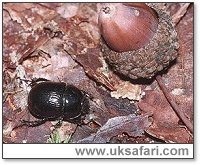
|

|
|
 Sent
to you Sent
to you
by e-mail
|
|
Simply
enter your details and hit the send button
more
info |
|


Click Here

Links
Advertise
Terms of Use
Contributors
About Us
Contact Us
|
 |
Go back
 | Bookmark
| Bookmark
 | Print Page
| Print Page  | E-Mail Us
| E-Mail Us 
 

Photo: G. Bradley |
|
UK
Safari Tip:
A great way to see all the details on Dor beetles is with a special
magnifier box - click here
|
|
Latin name: Geotrupes stercorarius
Size: Grows to 25mms long.
Distribution: Found throughout the UK.
Months seen: April to October.
Habitat: Farmland and woodland.
Food: Dung.
Special features: The Dor beetle is one of our largest dung beetles. Dung beetles get their name from their rather unattractive habit of eating dung. Both the larvae and the adults eat their own weight of dung every day. While this may seem a strange choice of diet, there is little competition for it, and they do perform a vital cleanup role in the countryside.
The Dor beetle is mainly associated with cow dung, and on summer evenings they can be seen flying over cattle pastures. Aerial maneuverability is not one of the
Dor beetles strong points, as they frequently crash into the cattle.
Mated pairs together work as a team to find a suitable cowpat, usually at night. The female then digs a hole underneath it, about 60cms deep, with some small chambers off to the sides. The male helps to clear the excavated soil, and brings small bundles of dung into the chambers. The female then lays an egg in each chamber. When the egg hatches, the larva has enough dung to eat for the first few months of its life. When fully grown the larva pupates underground, and the following year it emerges as an adult beetle.

UK Safari Beetle Section
UK Safari Creepy-Crawlies Section
|
 |

|